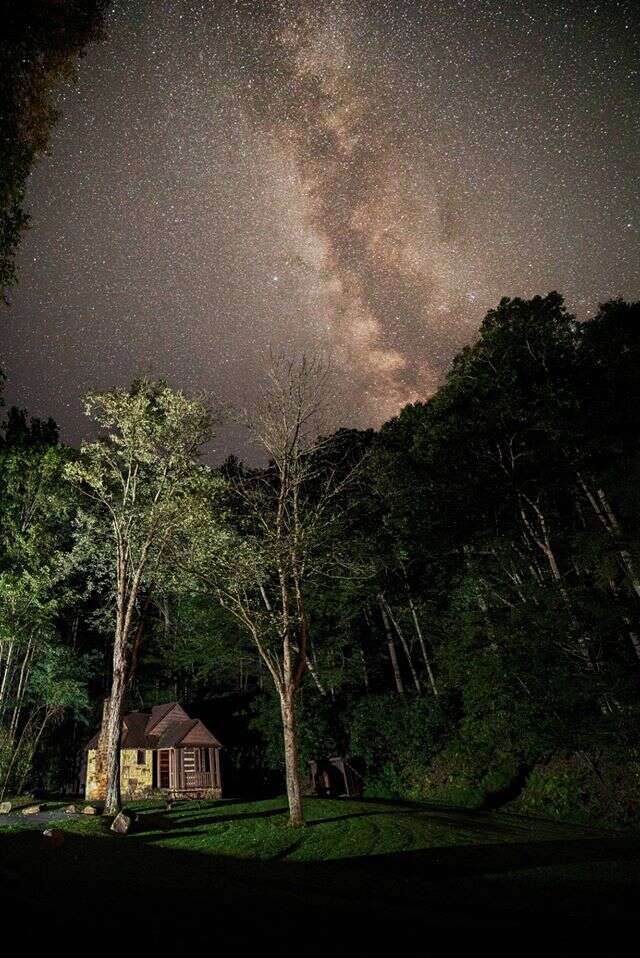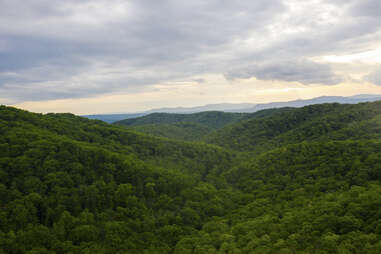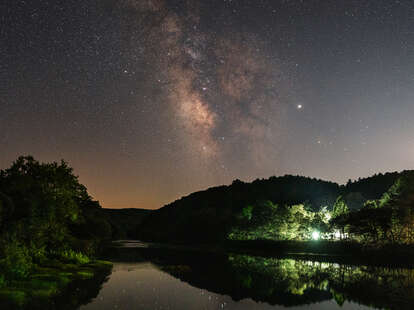This Appalachian State Park Has Some of the Darkest Skies in the Eastern U.S.
West Virginia's Watoga State Park is a stargazer’s paradise just a road trip away.
Satellite imagery of the US at night shows the entire eastern half of the country aglow. From Wichita, Kansas, to the Atlantic Coast, light sprays from every major city, reaching even the skies of rural Appalachia. That is, except for one tiny dark spot, where the constellations are clear and nocturnal critters from owls to fireflies abound. That tiny spot is Watoga State Park, in Pocahontas County, West Virginia.
This 10,000-acre oasis of old-growth forest sits under the darkest skies in the entire Mid-Atlantic. In 2021, the International Dark Sky Association (IDA) designated it and two nearby parks the first International Dark Sky Parks in the state and three of only 22 in the US that are situated east of the Mississippi River.
Watoga is West Virginia’s largest state park and one of its oldest, serving as a forest and wildlife preserve before opening to the public in 1937. Its name, which it shares with the surrounding community, is a Cherokee word that translates to “starry waters.” Since its Dark Sky designation, stargazing has become a big draw for Watoga State Park, bringing together seasoned astronomers and budding night-sky admirers for star parties, expert programs, and more.

What it means to be an International Dark Sky Park
Even though the Appalachian Mountains naturally shield Watoga from the artificial glow of its nearest metropolises, it took nearly three years for the park to prove it is dark enough for International Dark Sky status. Starting in 2019, with little funding and help from the community, the park began measuring light pollution and modifying 98% of exterior light fixtures to meet the IDA’s rigorous standards.
To be eligible for Dark Sky designation, all outdoor lights emitting 500 or more initial lamp lumens must be shielded, so that the light is directed at the ground and not the sky. The guidelines state that the Milky Way must be “readily visible to the unaided eye,” that “there are no nearby artificial light sources yielding significant glare,” and that “any light domes present are dim, restricted in extent, and close to the horizon.” The park must also “set a leadership example in the restoration of dark skies,” meaning it collaborates with other organizations and holds educational programs to spread awareness of the importance of darkness.
In an era of rapid population growth and constant development, preserving dark skies is the only way to conserve habitats for nocturnal animals. According to the National Park Service, “Dark night skies are essential to the rhythms of life on Earth.” One example is the firefly, a beloved symbol of summer once widespread across the Midwest, East Coast, and Mid-Atlantic. Now, experts estimate that one in three firefly species in the US and Canada is threatened with extinction, mostly due to habitat loss and light pollution. In 2019, the first spring of Watoga’s Dark Sky project, a rare species of synchronous firefly was discovered in the park.
Watoga State Park superintendent Jody Spencer says the Dark Sky designation of Watoga, along with nearby Calvin Price State Forest and Droop Mountain Battlefield State Park, has also boosted a lucrative industry for rural Pocahontas County, which is primarily known as the home of West Virginia’s largest ski resort (Snowshoe Mountain).
“The Dark Sky movement and Watoga's involvement has 100% increased tourism for the park and the area,” he says. “Even though planned programs are nice, it's still something that guests can simply enjoy on their own.” One astrophotographer who frequents the park, Jeff Ball, says it’s special to have a protected night sky that’s so accessible to much of the US population. “The awareness of dark skies so close to millions on the East Coast is another huge benefit of Dark Sky status.” Watoga is within a five-hour drive of populous cities like Washington DC, Pittsburgh, Charlotte, and Richmond.

The best places to stargaze at Watoga State Park
Spencer says the best spots for stargazing in Watoga are on the Watoga Lake Dam, right next to the park headquarters and gift shop, and the overlook at the Ann Bailey Trailhead, about a mile and a half from the headquarters. Both are open and mowed areas where you can set up stargazing and photography equipment. Ball, who showcases his astrophotography at earthandskyphoto.com, says his favorite views are around the lake. That’s where you’ll get amazing views of the Milky Way reflecting off the water.
Watoga State Park is also home to a campground and 34 cabins where you can stargaze right off your porch. If you don’t stay inside the park, there’s a 10 pm curfew, per statewide rules. Spencer says that stargazers are welcome in the park after the curfew, but they should call the park office ahead of time to inform staff of when they’ll be there and where they plan to be.
If you’re new to the hobby or don’t bring your own gear, there are local resources available. The Watoga State Park Foundation has partnered with Pocahontas County Libraries, the tourism bureau, and nearby Green Bank Observatory to provide astronomy backpacks that are free to borrow from the park headquarters and all library locations throughout the county. You don’t even have to be a resident. Visitors can get a temporary library card from any branch, permitting them to check out any item, including the backpacks, from that branch.
The astronomy backpacks include 10x50 binoculars, a tripod and connector for steadying the binoculars, a guidebook on exploring the night sky with binoculars, and two celestially inspired children’s books for families traveling with kids.

The best times to stargaze at Watoga State Park
Any time of year is a good time for stargazing. Of course, the best time to visit Watoga might be during the warmer months, when the trails are ripe for hiking, the campground and pool are open, and visitors can rent kayaks and paddle around the lake. All summer, there are star parties at Watoga and Droop Mountain Battlefield State Park, and Spencer says they also hold programs for special celestial events like meteor showers.
That said, winter is the best time to stargaze in general. The sky is clearer and easier to see without the haze of hot temperatures, and it gets dark much earlier, doubling the hours of night available in the summer. However, the weather can be unpredictable, and the road to get to the Ann Bailey Trailhead, Park and Forest Route 819, is closed in the winter.
Ball suggests a happy medium: “Mark your schedule around spring new moons to get under a dark sky and see the Milky Way cross the sky overnight,” he says.

Other things for stargazers to see and do in the area
Fewer than 10 miles from the start of Watoga Park Road is Droop Mountain Battlefield, West Virginia’s oldest state park and a landmark on the Civil War Discovery Trail. The highlight is a lookout tower, another stargazing hotspot a half-mile along the Lookout Trail from the park office. The third in Pocahontas County’s Dark-Sky trifecta is Calvin Price State Forest, about 50 miles from Watoga Park Road.
If you are fascinated enough by celestial activity to drive an hour to learn about radio astronomy, the Green Bank Observatory is a unique side trip. Located inside the 13,000-square-mile National Radio Quiet Zone, this observatory is home to the largest land object that humans have ever built, a moving 2.3-acre dish that listens to space. You can learn all about it inside the Science Center, which offers hour-long bus tours of the grounds four times a day, every day of the week.
Watoga itself is wonderfully isolated from touristy shops and restaurants, but when a break from campfire meals is in order, the Greenbrier Grille and Lodge in the endearing little riverside town of Marlinton, about 20 minutes away, has homey diner food and a flock of odd-breed ducks.
